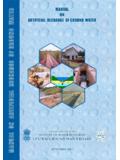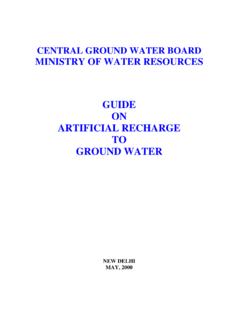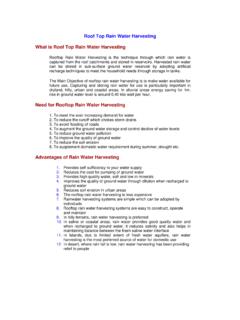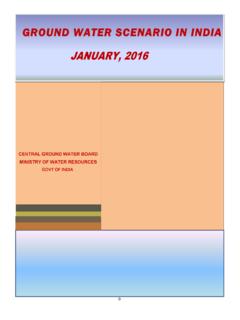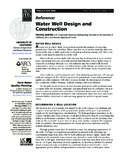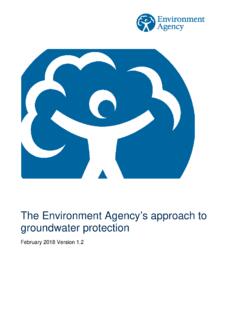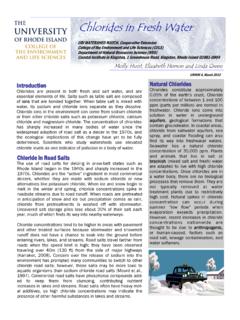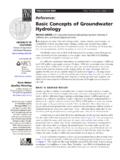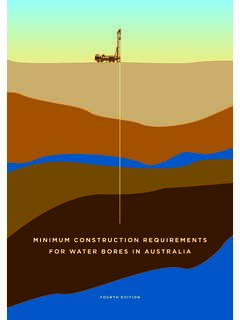Transcription of GROUND WATER RESOURCES AND THEIR MANAGEMENT …
1 Towards Better MANAGEMENT of GROUND WATER RESOURCES in India , Chairman & , Scientist D Central GROUND WATER Board Bhujal Bhawan, CGO Complex, NH IV, Faridabad- 121 001, Haryana, India. e-mail: Abstract Groundwater is the most preferred source of WATER in various user sectors in India on account of its near universal availability, dependability and low capital cost. The increasing dependence on GROUND WATER as a reliable source of WATER has resulted in indiscriminate extraction in various parts of the country without due regard to the recharging capacities of aquifers and other environmental factors. On the other hand, there are areas in the country, where GROUND WATER development is sub-optimal in spite of the availability of sufficient RESOURCES , and canal command areas suffering from problems of WATER logging and soil salinity due to the gradual rise in GROUND WATER levels.
2 As per the latest assessment, the annual replenishable GROUND WATER resource of country has been estimated as 433 billion cubic meter (bcm), out of which 399 bcm is considered to be available for development for various uses. The irrigation sector remains the major consumer of GROUND WATER , accounting for 92% of its annual withdrawal. The development of GROUND WATER in the country is highly uneven and shows considerable variations from place to place. Though the overall stage of GROUND WATER development is about 58%, the average stage of GROUND WATER development in North Western Plain States is much higher (98%) when compared to the Eastern Plain States (43%) and Central Plain States (42%).
3 MANAGEMENT of GROUND WATER RESOURCES in the Indian context is an extremely complex proposition. The highly uneven distribution and its utilization make it impossible to have single MANAGEMENT strategy for the country as a whole. Any strategy for scientific MANAGEMENT of GROUND WATER RESOURCES should involve a combination of supply side and demand side measures depending on the regional setting. As far as GROUND WATER resource availability is concerned the share of alluvial areas covering Eastern Plain states of Bihar, Orissa (part), Eastern Uttar Pradesh and West Bengal and North Western plain states of Delhi, Haryana, Punjab, Western Uttar Pradesh, Chandigarh; is about 44% of the total available resource .
4 However, these groups of states have overall development of the order of 43% and 98% respectively. In view of the marked difference in stage of GROUND WATER in these areas, there is a need to critically analyze the underlying factors responsible for the imbalances in terms of technical and socio-economic considerations. These should also be taken for consideration while formulating any comprehensive WATER RESOURCES MANAGEMENT initiatives for the country. There is urgent need for coordinated efforts by various Governments and non-governmental agencies, social service organizations and the stakeholders for evolving implementable plan for effective MANAGEMENT of this precious natural resource .
5 1. Introduction: Groundwater has emerged as the primary democratic WATER source and poverty reduction tool in India s rural areas. On account of its near universal availability, dependability and low capital cost, it is the most preferred source of WATER to meet the requirements of various user sectors in India. GROUND WATER has made significant contributions to the growth of India s Economy and has been an important catalyst for its socio economic development. Its importance as a precious natural resource in the Indian context can be gauged from the fact that more than 85 percent of India s rural domestic WATER requirements, 50 percent of its urban WATER requirements and more than 50 percent of its irrigation requirements are being met from GROUND WATER RESOURCES .
6 The increasing dependence on GROUND WATER as a reliable source of WATER has resulted in its large-scale and often indiscriminate development in various parts of the country, without due regard to the recharging capacities of aquifers and other environmental factors. The unplanned and non-scientific development of GROUND WATER RESOURCES , mostly driven by individual initiatives has led to an increasing stress on the available RESOURCES . The adverse impacts can be observed in the form of long-term decline of GROUND WATER levels, de-saturation of aquifer zones, increased energy consumption for lifting WATER from progressively deeper levels and quality deterioration due to saline WATER intrusion in coastal areas in different parts of the country.
7 On the other hand, there are areas in the country, where GROUND WATER development is still at low-key in spite of the availability of sufficient RESOURCES , similarly the canal command areas suffer from problems of WATER logging and soil salinity due to the gradual rise in GROUND WATER levels. In order to address various issues related to GROUND WATER , keeping in view the climatic change, there is a need to prepare a comprehensive road map with identified strategies for scientific and sustainable MANAGEMENT of the available GROUND WATER RESOURCES in the country so as to avert the looming WATER crisis. In addition to addressing the issues of declining WATER level, the strategies should also focus on the imbalances in GROUND WATER development in the country, reasons thereof and suggesting measures including accelerated development of GROUND WATER in areas with low stage of GROUND WATER development.
8 2. Hydrogeological Set up of the Country: India is a vast country with a highly diversified hydrogeologic set-up. The GROUND WATER behavior in the Indian sub-continent is highly complicated due to the occurrence of diversified geological formations with considerable lithological and chronological variations, complex tectonic framework, climatological dissimilarities and various hydrochemical conditions. The rock formations range in age from Archaean to Quaternary-Recent period. The Archaean rocks are present in the southern states where as the recent sediments are confined to Indo-Gangetic alluvial plains. The major Geological Formations are the 1) Consolidated formations represented by Igneous & Metamorphic rocks with major rock types consisting of granites, Charnockites, Quartzites & associated Phyllite, slate etc; basalts & associated igneous rocks.
9 2) The semi consolidated rock formations are represented by rocks of Mesozoic & tertiary period with major rock types represented by limestone, sandstone, pebbles & boulder conglomerates. 3) The unconsolidated formations belong to Pleistocene to recent period & represented by major rocks such as boulders, pebbles, different grade of sands, silt-clay. These rocks form the major potential aquifer zones. The Indian sub continent is occupied by major geological rock types such as metamorphics of pre Cambrian period, Igneous rocks represented by basaltic rocks of Cretaceous-Eocene period, Gondwana & Vindhyan rocks which are overlain by quaternary to recent sedimentary deposits.
10 The distribution of these rock types are given in geological map (Figure 1). Based on the formation characteristics and hydraulic properties to store and transmit GROUND WATER hydrogeologically all the litho units can be placed under two broad groups of WATER bearing formations Viz. Porous Formations which can be further classified into unconsolidated and semi consolidated formations having the primary porosity and Fissured Formation or Consolidated formations which has mostly the secondary or derived porosity. The Hydrogeological map showing the broad group of consolidated and unconsolidated WATER bearing formations along with THEIR yield prospects are shown in Physiographic and geomorphologic settings are among the important factors that control the occurrence and distribution of GROUND WATER .
